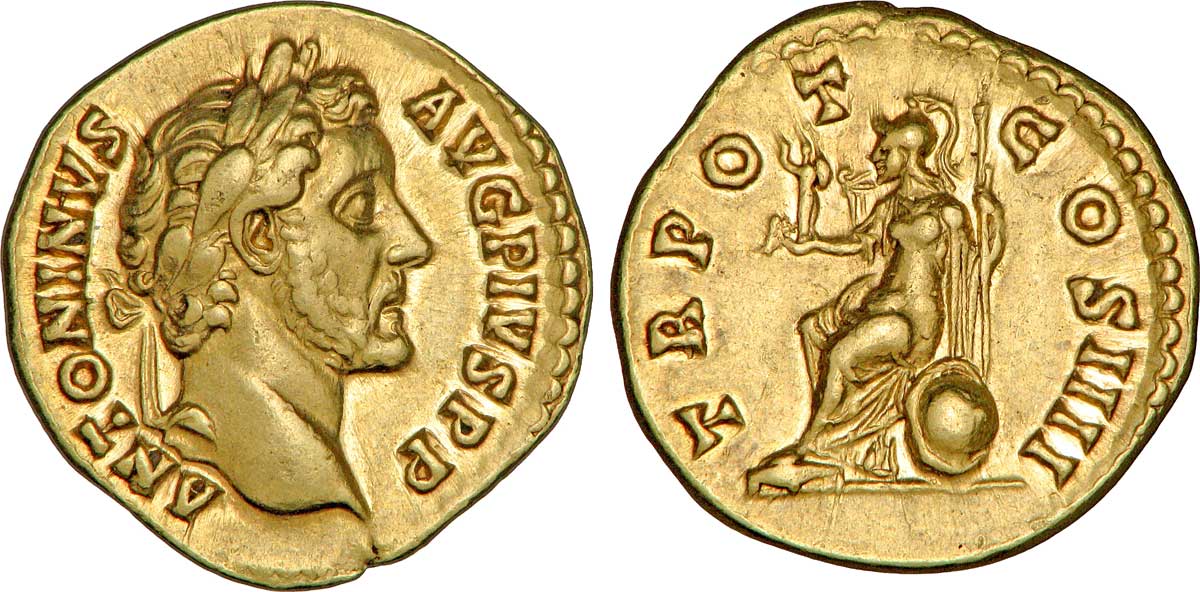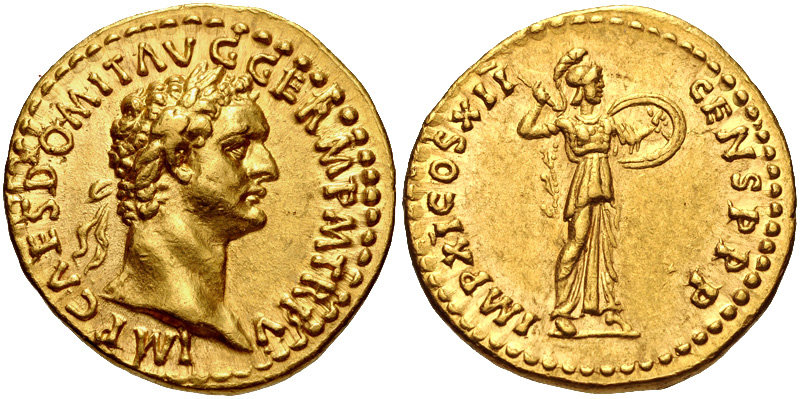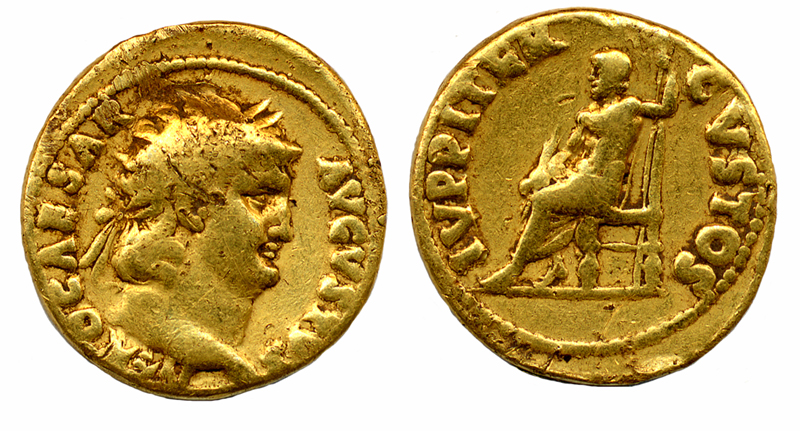Hello, last week I presented “5 Roman Coins in Silver”. In this article, I will therefore present “5 Roman Coins in Gold”. In the same way as in the previous article, we are going to do numismatics here. So we will decipher the coins and try to understand the messages they wanted to convey in Roman times. In this article, therefore, there will be analysis, description and interpretation. Good reading.
First Roman Coin in Gold : the aureus of Tiberius
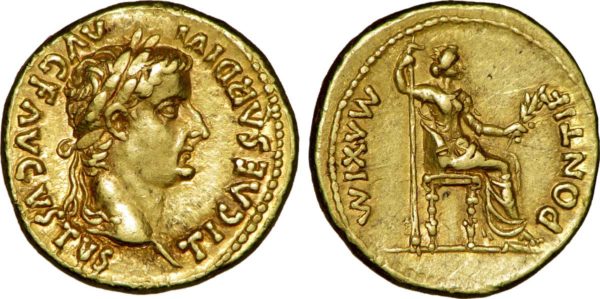
This first Roman coin is an aureus of Tiberius. Tiberius is a Roman emperor born on November the 16th, 42 BC in Rome and died on March the 16th, 37 AD in Misene (city of Italy). Tiberius is therefore the successor of Augustus and therefore the second Roman emperor. He became emperor on August 19, 14 AD, at the age of 55. His reign therefore ended with his death on March the 16th, 37 AD. At the time he was 77 years old which is an advanced age for the time. The causes of his death remain very unclear. Indeed, several theories remain that he died of natural causes, disease or even an assassination.
This gold coin weighs 7.65 grams for 19 mm in diameter. On its obverse, we can see the bust of Tiberius, surrounded by the captions “TI CAESAR DIVI AVG F AVGVSTVS” (Tiberius, Caesar, son of the divine Augustus, Augustus). On its reverse, we can see the Pax seated on a throne, holding an olive branch in her left hand and a long scepter in her right hand. The inscribed captions are “PONTIF MAXIM” (Grand Pontiff). This coin was therefore minted to celebrate Tiberius as the son of Augustus and this when he was “Caesar”, “August” and “Grand Pontiff”.
Small remark on this coin, unlike most other Roman coins, on this one, the legend is read from right to left and not from left to right.
Second Roman Coin in Gold : the aureus of Antoninus Pius
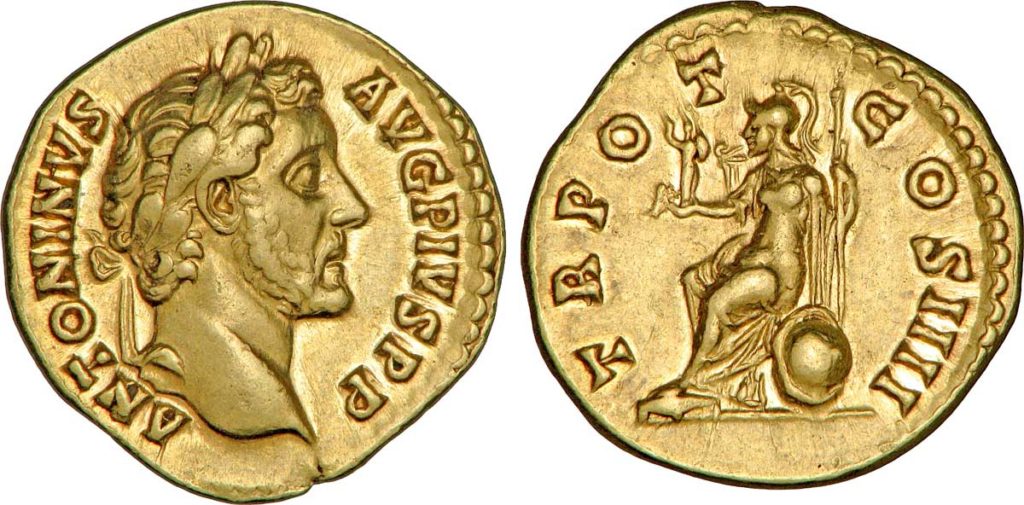
This second Roman coin is an aureus of Antoninus Pius. Antoninus Pius is a Roman emperor born on September the 19th, 86 AD in Lanuvium (Italian city) and died on March the 7th, 161 in Lorium (Italian city). He is Hadrian’s successor. During his reign, he had a very peaceful approach, making neither war nor conquest. Moreover, he is considered to be the emperor who marked the decline of the Roman Empire. This is because the height of the Empire took place during his reign and therefore the Empire never saw better days thereafter. The Pious died in 161 AD from illness and was succeeded by Marc-Aurèle.
This gold coin weighs 7.12 grams with a diameter of 20 mm. On its obverse, we can see the bust of Antoninus Pius, surrounded by the captions “ANTONINVS AVG PIUS PP” (Anntonin, august, pious, father of the country). On its reverse, we can see Roma, seated on a shield, holding a palladium in her right hand and a long scepter in her left hand. The inscribed captions are “TR POT COS IIII” (Clothed with the tribunitian power, consul for the fourth time). This coin was therefore minted when Antoninus Pius held various titles such as “auguste”, “father of the fatherland” and when he was “vested with tribunitian power”. But also, this coin celebrates the fact that he was consul for the fourth time.
Third Roman Coin in Gold : Aureus of Faustina The Young
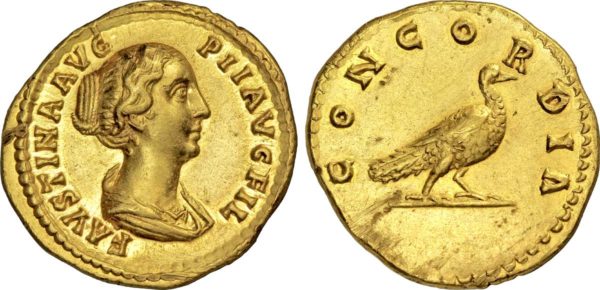
This third Roman coin is an aureus of Faustina The Young. Faustina The Young is a Roman empress born around the year 128 AD and died in 175 AD. She is the daughter of Antoninus Pius and Faustina Mother. Faustina marries Marc-Aurèle in 145 AD and becomes empress: “Augusta” in 146 AD. She died in 175 AD, in the Halala military camp. Moreover, the latter will be renamed “Faustinopolis” in homage to the deceased.
This gold coin weighs 7.30 grams with a diameter of 18 mm. On its obverse, we can see the bust of Faustina The Young, surrounded by the captions “FAVSTINAE AVG PII AVG FIL” (Faustina, august, daughter of the pious august). On its reverse, we can see a dove walking to the right. The captions entered are “CONCORDIA” (the Concorde). This coin was therefore struck when Faustina The Young bore the title of “Augusta”. But, she was also struck to celebrate Faustina as the daughter of Antoninus Pius.
Fourth Roman Coin in Gold : the solidus of Constantine I
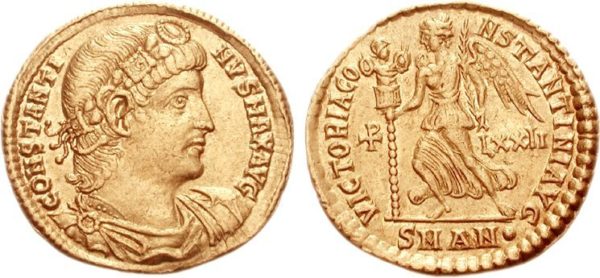
This fourth Roman coin is a solidus of Constantine I. Constantine is a Roman emperor born on February the 27th, 272 AD in Moesia (city in Serbia) and died on May the 22nd, 337 AD in Nicomedia (city of Bithynia). It was in 306 AD that he was proclaimed Roman Emperor. His reign will have been very important to the Empire. Indeed, he put in place various reforms (political, monetary …) which made it possible to unite the Empire which was at that time divided. He will also have played a very large role in the defense and popularization of Christianity. He died in 337 AD, after one of the longest reigns (31 years).
This gold coin weighs 4.55 grams for 21 mm in diameter. On its obverse, we can see the bust of Constantine I, surrounded by the captions “CONSTANTINUS MAX AVG” (Constantine very great august). Victoria can be seen on her lapel, holding in her right hand a scepter surmounted by a trophy and a palm in her left hand. To the left of the victory is the chrism and to its right the number LXXII (72). The inscribed captions are “VICTORIA CONSTANTINI AVG” (Victory of Augustus Constantine). This coin was therefore certainly minted in order to celebrate a victory of Constantine. Also, the chrism obviously represents the Christian religion, very important for Constantine I. And finally, the number “LXXII” means 72 or 1/72 of pounds so 4.55 grams. It is in fact an indication of the weight of the coin.
Fifth Roman Coin in Gold : the solidus of Arcadius
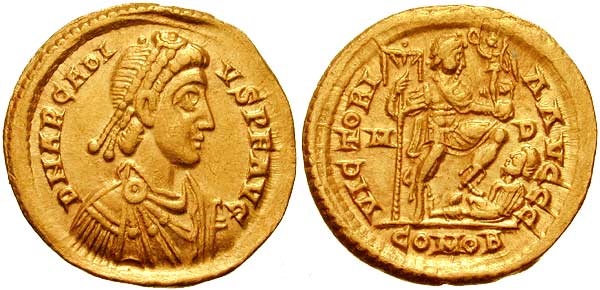
This fifth Roman coin is an Arcadius solidus. Arcadius is an East Roman Empire Emperor born in 377 AD and died in 408 AD. Following the death of his father: Theodosius I, he became Roman Emperor in 395 AD and ruled half of the Empire. Indeed, the Empire was divided into two parts: the West for Honorius (the brother of Arcadius) and the East for Arcadius. During his reign this last, being rather weak and inexperienced, was strongly influenced and required a lot of advice. So he didn’t make big decisions. He died in 408 AD and was succeeded by Theodosius II.
This gold coin weighs 4.45 grams for 21 mm in diameter. On its obverse, we can see the bust of Arcadius, surrounded by the captions “D N ARCADIVS PF AVG” (Our lord Arcadius, pious and happy august). On his lapel, we can see Arcadius standing, dressed in military style, holding a standard in his right hand and a globe in his left hand. He has his foot on a prisoner with his hands tied. The inscribed captions are “VICTORIA AVGGG” (The victory of the Augustus). This coin was therefore struck when Arcadius was august but also, this coin seems to celebrate a victory. Indeed, the representation of the emperor seems to show his victory. In addition, the captions “The victory of the august” confirms this idea. This coin was therefore certainly struck following a victorious battle for Arcadius.
Here are the representations of 5 Roman gold coins. I hope you enjoyed this article and that it taught you some things. Also, feel free to comment on what coins you would like me to feature or just what you think of this article. Also, tell me what topic you would like me to talk about in a future article. In fact, the next one will be on an important subject of numismatics “How to identify a Roman coin? “. See you next week !
Receive my free book Around Roman the Coin by clicking here

